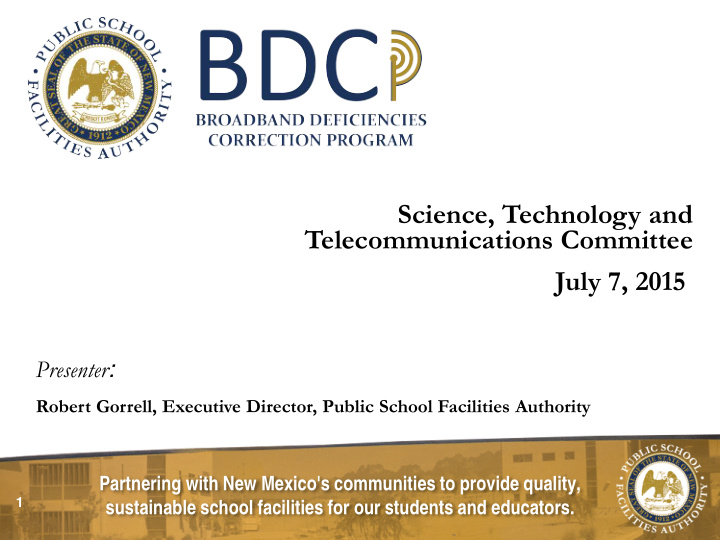



Science, Technology and Telecommunications Committee July 7, 2015 Presenter : Robert Gorrell, Executive Director, Public School Facilities Authority Partnering with New Mexico's communities to provide quality, 1 sustainable school facilities for our students and educators.
Program Necessity Broadband Deficiencies Correction Program (BDCP) • SB159 was signed into law with an emergency clause in March 2014 because there is a critical need, especially in rural areas, for adequate broadband within public schools across the State of New Mexico • Many other States are ahead of New Mexico in their efforts to upgrade broadband (Arkansas, Nebraska, Utah, Idaho, Mississippi, Pennsylvania…) Partnering with New Mexico's communities to provide quality, 2 sustainable school facilities for our students and educators.
High-Level View As displayed below, broadband originates from Internet Service Providers (ISP), is distributed to schools and then reaches students via end-user devices. The green area is covered by the BDCP. Partnering with New Mexico's communities to provide quality, 3 sustainable school facilities for our students and educators.
Program Overview Broadband Deficiencies Correction Program (BDCP) • Speed standard is between 100 kbps (kilobits per second) per student and staff and 1,000 kbps per student and staff (matching SEDTA and FCC recommendations) Partnering with New Mexico's communities to provide quality, 4 sustainable school facilities for our students and educators.
Program Necessity Broadband Deficiencies Correction Program (BDCP) • Reliable broadband is essential for 21 st century education Online Testing with expected increased video content (PARCC or other) Distance Learning such as the ABQ Public Schools’ (APS) virtual school called eCADEMY Resources for Instruction Homework Bring Your Own Device/Technology (BYOD/BYOT) One to One (1:1) Student to Device ratio Cloud Hosting Teacher professional development, etc. Partnering with New Mexico's communities to provide quality, 5 sustainable school facilities for our students and educators.
Program Funding Broadband Deficiencies Correction Program (BDCP) • The PSCOC may approve up to $10 Million per year for this program, totaling $50 Million over the course of five years (FY15 – FY 19) • E-rate may cover up to 90% of eligible expenses for NM schools • Additional E-rate discounts are given when States: Match funds for high-speed broadband construction (up to 10%) Use the consortium approach, and higher priority is given to these applications Partnering with New Mexico's communities to provide quality, 6 sustainable school facilities for our students and educators.
Program Overview Broadband Deficiencies Correction Program (BDCP) • Utilize and Manage Vendor Expertise Hewlett Packard (HP) Information technology professionals with experience working on similar broadband initiatives CTC Technology and Energy (CTC) Statewide distribution modeling and e-Rate UNM’s Earth, Data Analysis Center (EDAC) State repository for broadband mapping • Utilize Workgroups to develop vision, program standards, guidelines, and procedures HP Technical Representatives, School/District IT Professionals, DoIT’s “A Team,” PED, and so on… Partnering with New Mexico's communities to provide quality, 7 sustainable school facilities for our students and educators.
Program Overview Broadband Deficiencies Correction Program (BDCP) • Ongoing collaboration with other State agencies or groups with similar initiatives NM Department of Information Technology (DoIT) – Advisor NM Public Education Department (PED) – Advisor NM Public Regulation Commission (PRC) – Task Force NM Exchange Carrier Group and other NM Service Providers Higher Education – UNM, NMSU, NM Tech, Community Colleges, etc. RediNet – A successful public/private model • There is a shared sense of urgency and support for broadband in public schools among all participants Partnering with New Mexico's communities to provide quality, 8 sustainable school facilities for our students and educators.
Program Phases Broadband Deficiencies Correction Program (BDCP) • The BDCP’s two phases: Phase 1 – Program development and data collection phase for approximately 900 public schools statewide, including data centers Phase 2 (early 2016) – Corrections phase Partnering with New Mexico's communities to provide quality, 9 sustainable school facilities for our students and educators.
Phase 1 Status – On Schedule! Broadband Deficiencies Correction Program (BDCP) Phase 1 expectations: • Phase 1A ( Complete ): Development of methodology for school surveys (HP) and related web interface and completion of Estancia pilot between December 2014 and January 2015 • Phase 1B ( Complete ): Expanded pilot to 35 schools, including the APS data center, to verify methodology in February 2015 • Phase 1C ( Underway ): Statewide survey between May 2015 and October 2015 • Phase 1D ( Underway ): Data Compilation & Analysis and Proficiency Profile Map between February 2015 and October 2015 Partnering with New Mexico's communities to provide quality, 10 sustainable school facilities for our students and educators.
Program Phases Broadband Deficiencies Correction Program (BDCP) • Phase 1 deliverables are due in October 2015: Palette of solution-based options that advise: Capital infrastructure investment Ongoing operational costs • The goal is to determine the most cost-effective solution to deliver scalable, reliable, and sustainable broadband service to schools • We have to stay on schedule; we don’t want to miss out on an entire year of E-rate funding Partnering with New Mexico's communities to provide quality, 11 sustainable school facilities for our students and educators.
Conclusion Broadband Deficiencies Correction Program (BDCP) • The BDCP is on schedule and momentum is strong • Clear direction from leadership that all participants collaborate and eliminate potential duplication remains essential to efficient solutions • Shortly following PSFA’s release of options in October 2015, leadership’s timely selection of a high-level plan will allow greater access to out-of-state funding • The PSFA appreciates your ongoing support Partnering with New Mexico's communities to provide quality, 12 sustainable school facilities for our students and educators.
Questions or Comments? Public School Facilities Authority (PSFA) Kendra Karp – Chief Information Officer Ovidiu Viorica – Broadband Program Manager visit: www.NMPSFA.org or phone: 505-843-6272 13
Recommend
More recommend